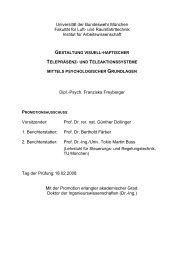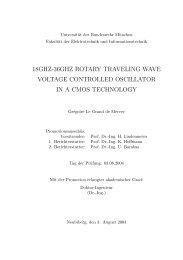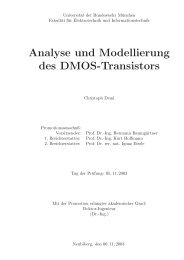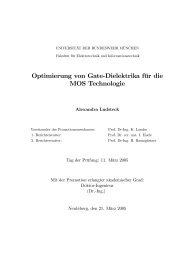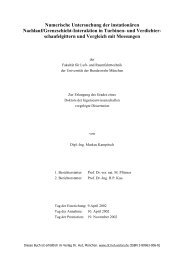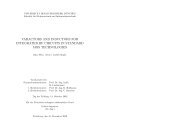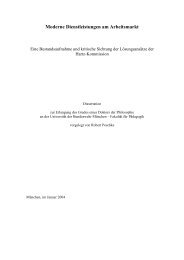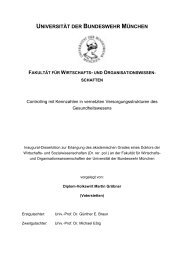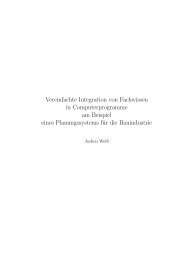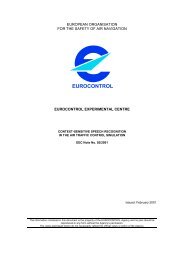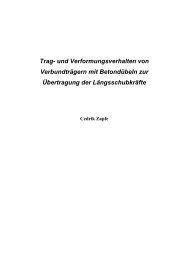Precise Orbit Determination of Global Navigation Satellite System of ...
Precise Orbit Determination of Global Navigation Satellite System of ...
Precise Orbit Determination of Global Navigation Satellite System of ...
Create successful ePaper yourself
Turn your PDF publications into a flip-book with our unique Google optimized e-Paper software.
Chapter 6 Algorithms <strong>of</strong> <strong>Orbit</strong> <strong>Determination</strong> <strong>of</strong> IGSO, GEO and MEO <strong>Satellite</strong>s<br />
CHAPTER 6 ALGORITHMS OF ORBIT DETERMINATION FOR<br />
IGSO, GEO & MEO SATELLITES<br />
6.1 Numerical Integration<br />
According to Newton's gravitational law, the satellite movement equation can be written as (Escobal, 1976)<br />
ϖ<br />
ϖ&r<br />
r<br />
=−µ (6-1)<br />
3<br />
r<br />
where,<br />
ϖ&r satellite acceleration vector in inertial coordinate system<br />
ϖ<br />
r satellite position vector in the same coordinate system<br />
µ the earth's gravitational constant<br />
Practically, the satellite is affected by various factors such as nonspherical earth gravitation, solar and lunar<br />
attractions, solar radiation, etc. Therefore the satellite movement equation can be more accurately expressed as<br />
ϖ<br />
ϖ&r<br />
r ∂R<br />
=− µ +<br />
(6-2)<br />
3<br />
r ∂t<br />
where R is a perturbation function <strong>of</strong> the sum <strong>of</strong> various perturbation sources mentioned above.<br />
Usually, there are two kinds <strong>of</strong> methods to solve this equation, analysis solution and numerical integration. The<br />
analysis method is complicated and the solution is low accuracy. The numerical integration is widely used and<br />
very rigorous, but time consuming for computation, especially for computation <strong>of</strong> complicated perturbation<br />
models. Two common algorithms <strong>of</strong> numerical integrations are Runge-Kutta and Adams-Cowell (Cappellari et<br />
al 1976, Xu 1989 and Engeln-Müllges et al, 1996).<br />
6.1.1 Runge-Kutta Integration<br />
The solution <strong>of</strong> satellite movement equation can be considered as solution <strong>of</strong> the initial value problem <strong>of</strong> the<br />
following differential equation, i.e.<br />
yt &( ) = f( yt ,) �<br />
�<br />
yt ( 0) = y0<br />
�<br />
Please note in Eq.(6-3), y=(y1,y2,y3,y4,y5,y6), which can be expressed as six Kepler orbital parameters.<br />
The differential equation (6-3) can be solved by explicit Runge-Kutta algorithm as follows (Cappellari et al<br />
1976, Xu 1989)<br />
m<br />
�<br />
yn+ 1 = yn + � wiki �<br />
i=<br />
1<br />
�<br />
i−<br />
�<br />
(6-4)<br />
1<br />
�<br />
ki = f( tn + cih, yn + h aijkj) �<br />
�<br />
j=<br />
1<br />
�<br />
where<br />
h step length <strong>of</strong> integration<br />
f( ) the right function <strong>of</strong> satellite movement equation<br />
m order <strong>of</strong> Runge-Kutta method<br />
wi<br />
weighted coefficients<br />
coefficients<br />
ci , ki, aij<br />
In precise orbit determination, 8-order <strong>of</strong> Runge-Kutta integration algorithm should be used, which is given by<br />
(Cappellari et al 1976, Engeln-Müllges et al, 1996, Xu 1989)<br />
65<br />
(6-3)



